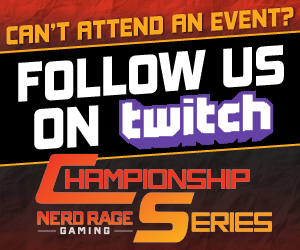Mat Bimonte: Where. Is. My. Dragon?
Last weekend was the Legacy Grand Prix in Columbus, but as someone with four lifetime competitive rules enforcement level Legacy matches played, I’ll defer to the rest of our great authors on that subject. What I do want to talk about this week is the standard format looking forward.
A couple weekends ago I was lucky enough to be able to attend SCG:Atlanta. This standard season is very vast. Many decks are playable, and many decks are right on the cusp. In my preparation for the event I tested more decks than I have ever tested before an event. I played:
GW Tokens
Monowhite Humans
Bant Humans
RW Eldrazi Burn
Grixis Control
Abzan Seasons Past
Cryptolith Rites decks
B/W Control
When the dust settled, I decided that even though Black/White Control was what we gathered to be the “best deck in the format,” the matchup against Green/White tokens was going to be very hard, and that just wasn’t a place that I wanted to be for the weekend. This ended up being a pretty good assessment, as a third of the Top 32 ended up being the Tokens deck. With Black/White being eliminated, I looked to G/W Tokens, but decided against it because the mirror match seemed abysmal. Where did that take me?
Well, I wanted to be prepared against G/W Tokens and B/W Control, and I thought this deck had the tools to do just that.
The consensus from people writing about and playing these types of decks  (Mostly Luis Scott-Vargas and others from Channel Fireball) was that it crushed Tokens, but had a hard time against Languish decks. On paper this makes sense, and in a world full of tokens I thought this is where I wanted to be. It comes as no surprise that blinking Atarka with an Eldrazi Displacer seems absolutely insane; if you haven’t done it, give it a shot. You’ll feel dirty.
(Mostly Luis Scott-Vargas and others from Channel Fireball) was that it crushed Tokens, but had a hard time against Languish decks. On paper this makes sense, and in a world full of tokens I thought this is where I wanted to be. It comes as no surprise that blinking Atarka with an Eldrazi Displacer seems absolutely insane; if you haven’t done it, give it a shot. You’ll feel dirty.
The deck felt very strong in my early testing. As I alluded to, it was destroying all of the Tokens decks I was playing, but I felt susceptible to Radiant Flames and Languish. I am as big a fan of Elvish Visionary and Eldrazi Skyspawner as they come, but those are the cards that match up worst against the controlling decks in the format. I swapped the four Visionary out for four Sylvan Advocate, and the four Skyspawners eventually became four Matter Reshapers to add an early beatdown plan to our deck and to be better against those sweepers.
The reasoning behind the changes was two-fold. One, the beatdown plan, and two, I love opening up sideboard slots with cards that are just fine in the main deck. That being said, four sideboard slots opening up is huge! Here is what I ended up playing:
My deck felt very strong throughout the day. I demolished almost every creature deck I played against, and won twice against B/W Control, which felt great, especially post board. I ended the day at 6-3; one of my losses was to the U/R Ulamog  deck, which didn’t feel very good for me; the other two losses were in game 3’s where I mulliganed to six and mulliganed to four (almost won this one). The mulligans were easy ones also, either all lands, or all spells. With smoother openers I believe I could have reasonably went 8-1 on the day.
deck, which didn’t feel very good for me; the other two losses were in game 3’s where I mulliganed to six and mulliganed to four (almost won this one). The mulligans were easy ones also, either all lands, or all spells. With smoother openers I believe I could have reasonably went 8-1 on the day.
Now for the golden question. Would I play this deck again? 100 percent yes. With reasonable draws I felt like I was in every single game I played over the weekend. I really wanted 6-3 to make it into day 2, because I felt my 75 was capable of winning all 6 matches on day 2. With the continued dominance of Green/White Tokens, I would recommend playing this deck if it is something you are actively trying to beat.
The cards I want to be playing in Standard are pretty limited after a bunch of play testing. Duskwatch Recruiter, Reflector Mage, and Eldrazi Displacer are likely the best things you can be doing right now, and probably the reason to play this deck. Having Dragonlord Atarka as your top end is great in a world full of tokens and humans as it is one of the best things you could be doing against them.
The other million-dollar question: What would I change? I honestly think the main deck is about as finely tuned as I can get with minimal shifts in the metagame. The sideboard is something that I need to revisit though. Tom Ross’s aggressive White Humans deck is tough for this deck if you don’t start quickly out of the gates. I would remove the Archangel Avacyns for either Declaration in Stone or Lambholt Pacifist. Lambholt Pacifist has synergy with Collected Company and is a good blocker, while Declaration in Stone gives the deck access to hard removal for matchups where it calls for it, like clearing tokens away from Green-White. The Stratus Dancers are also on the table, but I really love having Negate on a body for the controlling decks. The flying is also important for early attacking, and countering Languish or Radiant Flames are huge pluses as well.
or Lambholt Pacifist. Lambholt Pacifist has synergy with Collected Company and is a good blocker, while Declaration in Stone gives the deck access to hard removal for matchups where it calls for it, like clearing tokens away from Green-White. The Stratus Dancers are also on the table, but I really love having Negate on a body for the controlling decks. The flying is also important for early attacking, and countering Languish or Radiant Flames are huge pluses as well.
Wrap Up
As you can see, the deck is very flexible and can be customized to all flavors of meta, which is why I think it is a great choice for any given weekend. I highly recommend my 60, and even my 75, for PPTQ season, and the next event you plan on playing in. If you have any questions regarding sideboard tips, or general gameplay lines, feel free to comment below, or find me on Twitter or Facebook. Good luck, and I hope to see you at the next event!
Thanks for stopping by,
Mat Bimonte
Mat Bimonte first picked up the game during Theros block, but already has a Modern 5K championship under his belt, as well as a number of smaller Standard tournament wins. Based out of Bloomington, Ill., Mat is a regular on the SCG Tour, with future aspirations of qualifying for the Pro Tour.




